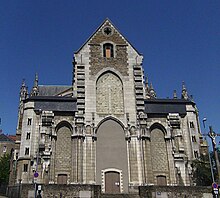Église Saint-Similien
| Église Saint-Similien | |
|---|---|
 |
|
| 47°13′13.33″N 1°33′34″E / 47.2203694°N 1.55944°ECoordinates: 47°13′13.33″N 1°33′34″E / 47.2203694°N 1.55944°E | |
| Location | Nantes |
| Country | France |
| Denomination | Roman Catholic |
| Website | http://paroisse-saintseveques-nantes.fr/ (in French) |
The Church of St. Similien, Nantes is an ancient church, in the Hauts-Pavés district of Nantes, France.
It is dedicated to Similien of Nantes and is located on the northwest side of the Place Saint-Similien.
After the death of Bishop Similien 17 June 310, his successor, Eumilius, erected over his grave a votive chapel.
One hundred years later, the bishop Leo, a Greek (444-458) built a real church 20 meters long and 9 meters wide which is also called "Holy Sambin". It ends east exedra by a narrow apse of 4 meters in diameter. The building, which then dominates the "Bourgneuf", built in square stones interspersed with brick chaining, will be dedicated on 24 June 419, day of the Nativity of St. John the Baptist. It also has the oldest baptismal fonts of Nantes (fifth century). At the end of the fifth century, Gregory of Tours designated the church as the Basilica antistis Similini, in his De gloria Martyrum saying was dedicated to Saint-Donatien. In 848, Nantes is vandalized during the Norman invasions. If the church is not destroyed, it is nevertheless looted, and the saint's relics deposited at the well (which still exists) disappear at that time. In 958, a procession allows to Gauthier bishop and his canons, to launch a public subscription to undertake the restoration of the building, which will be completed towards 1172, by the Duke Geoffroy II.
Following the siege of Nantes by Louis XI in 1487, Bishop Peter of Chaffault, repaired and enlarged the basilica Building it in the form of a Latin cross. The apse is Merovingian but the nave was extended towards the west, and flanked by two crosses. The bell tower to the west, raised 1.20 meters above street level measured 32.43 m high and consisted of: a square tower with a height of 17.30 m and an area of 30 m2, supported by buttresses and decorated with narrow basket-handle windows to illuminate the staircase; a wooden belfry in the form of 3,50 m high needle; a pavilion with a height of 6.05 m; a slate arrow of 3.48 meters high topped by a ball and a cross with a height of 2 meters [1].
...
Wikipedia
